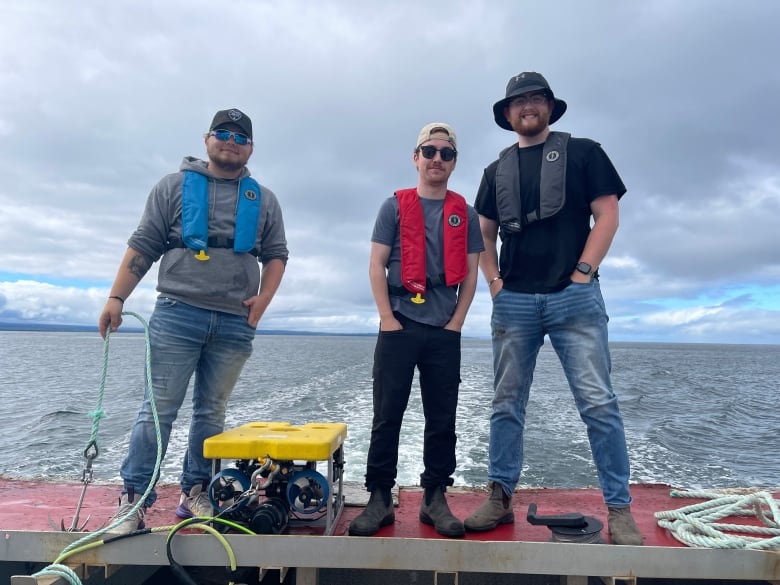
[ad_1]
When fisheries technologist Mark Santos and his team of student researchers depart from the port of Stephenville, N.L., they’re not looking for lobsters, crabs or mackerels.
They’re looking for “ghost gear” — fishing equipment lost in the deep, washed away by post-tropical storm Fiona.
“I usually work with gear technology, so actually testing gear and helping clients test out new fishing gear,” he told The Current‘s Matt Galloway.
“But this ghost gear project came along, and I’ve always had an interest in it, so I kind of took it on.”
“Ghost gear,” which can include anything from pieces of rope to lost crab or lobster traps, has been haunting Canadian waters for years. But after Fiona ripped through the Maritimes last September, the waters surrounding Canada’s east coast became inundated with more lost loot.

That’s why earlier this year, Fisheries and Oceans Canada (DFO) launched a call for applicants to the Ghost Gear Fund, a federally funded program intended to clean up the waters. The DFO is also working to replace some of the lost equipment.
As of Sept. 1, the Ghost Gear Fund has funded 91 projects for a total of $26.7 million — including the Centre for Sustainable Aquatic Resources, an applied research unit within Memorial University’s Marine Institute, which received nearly $1.1 million from the fund.
Project lead Santos started their retrieval mission in mid-August. He said they’re using sonar and remotely operated vehicles (ROVs) to help recover pieces of ghost gear.

“In open water, when you start talking about stuff that’s down 60, 70, 100 metres … you’re not getting a person down there. ROV is probably a better option,” he said.
A burden for fish and fishermen
So far, Santos said his team have found more than 2,000 potential targets along the shores.
It’s important to catch things as seemingly mundane as ropes or a net because “it’s a trap that’s down there that continuously fishes,” Santos said.
“So either an animal goes into it, dies, attracts more animals and the cycle continues … or it’s a situation of a net that continuously fills with fish, it rots out, sinks to the bottom, and then as it rots, it floats back up, catches more fish,” he said.

For fisherman like Renny Hickey, ghost gear is also an expensive loss.
“Traps are like $250 a piece, and you have as [many] as 20 lobsters in a trap,” he said. “You lose one, it could cost a guy … $600 per trap.”
Hickey has been a fish harvester in Newfoundland for 30 years, following in the currents of his father. He said the amount of gear he could lose adds up over the years.

That’s why he’s willing to volunteer the 39-foot vessel belonging to his son — also a fish harvester — to Santos and his crew.
“We chose this boat because it has a large deck, and so it’s going to be beneficial for us if we start getting into a lot of gear,” Santos said.
“We have storage space, and space to kind of sort it out and do our sampling, because if we find gear that has specimens in it, we actually have to record what’s in the trap — and that’s a DFO requirement.”
Fishing with tech
The boat also gives Santos and his team space to carry their equipment, including several ROVs, all of which have their own unique quirks and benefits.
Three of them are small and manoeuvrable, while a larger one is used to travel through heavy currents. “It has three one-horsepower motors. So we can push through the current pretty well,” Santos said.
The ROVs are remote-controlled, and they can give researchers a limited view of the aquatic floor when they’re released underwater.
“The field of view is not huge,” he said. “So, I mean, you kind of got to pick an area, pick a transaction, kind of go on it, and then hopefully something comes on in your view.”

The larger ROV is used to survey the waters and locate the debris. Then they can deploy the smaller craft, which are equipped with a manipulator arm with a “little claw,” Santos said, to pick up ghost gear from the seabed.
Santos thinks ROVs are a smarter and more environmentally respectful method of retrieving ghost gear than the usual method of using a grapnel, which blindly drags across the floor in the hopes of hooking onto something.
“Dragging a grapnel across here … will disturb the worms and other habitats, but you’re not going across a coral bed or anything like that,” he said.
“But with this type of tech, we could actually go across the coral bed and not cause any problems.”
[ad_2]
Source link

التعليقات